| Total population | |
|---|---|
| 1,116 (2010) [1] | |
| Regions with significant populations | |
| Kalimpong · Mundgod · Visakhapatnam · Pune · New Delhi | |
| Languages | |
| Mongolian · Tibetan · English · Sanskrit | |
| Religion | |
| Buddhism |
There is a small Mongolian community in India, comprising mostly Buddhist monks and scholars as well as international students from Mongolia.
Mongolians who were originally studying in Tibet in the 1950s followed the Tibetans and fled to India after the 1950 invasion of Tibet and the 1959 Tibetan uprising. Many of them settled in Kalimpong, West Bengal. [2] The Dilowa Hutukhtu maintained contact with them. American scholar Owen Lattimore suggested to then-Defence Minister of India Krishna Menon that they could be valuable sources of intelligence against the People's Republic of China about conditions in Tibet. [3]
Mongolian scholars from Tibet made valuable contributions in Indian academia; for example, Lama Chimpa assisted George de Roerich in compiling a Russian-Sanskrit dictionary. Other noted Mongolian scholars in India from this era include Da-Lama, Rigzin Wangpo, Geshe Wanggyal, Geshe Kaldan, and Geshe Agwang Nima; some remained in Kalimpong, while others left the district to teach at famous universities including the Banaras Hindu University and the University of Delhi. Most continued as monks, but some returned to secular life, married, and had children. Tohtoh, one such young man, studied at the Central Tibetan School in Mussoorie, Uttarakhand before emigrating to the United States, where he was involved in founding the Mongol-American Cultural Association. [2]
Ties between Mongolia and India were expanded by the efforts of the 19th Kushok Bakula Rinpoche. He was originally from Ladakh in India, but went to Lhasa to study at Drepung Monastery in the 1930s. He was instrumental in reviving Buddhism in Mongolia, arranging the Dalai Lama's visit to Mongolia in 1979, which resulted in an agreement for monks from Mongolia to come to India to study Buddhism. During his service as India's ambassador to Mongolia he encouraged more Mongolian monks to come to India and study at the Institute of Buddhist Dialectics in Dharamsala, in Karnataka at the Drepung Gomang in Mundgod or the Sera Monastery in Bylakuppe, and in other places. Due to his efforts the number of scholarships for Mongolians to study in India expanded from just a few to over one hundred. [4]
In January 2004, India and Mongolia also signed an agreement to construct a Mongolian-run Buddhist temple in Bodh Gaya, Bihar, where according to Buddhist tradition Gautama Buddha attained enlightenment. The Bihar government gave a free grant of land on which to build the monastery; then-Prime Minister of Mongolia Nambaryn Enkhbayar personally laid the foundation stone. Construction was delayed due to a dispute with the local government, however the temple was inaugurated in 2017 by the Dalai Lama . [5] [6]
Penor Rinpoche's Kunzang Palyul Choling, in partnership with the Khamariin Khiid in Sainshand Sum, Dornogovi Province, Mongolia, began sponsoring Mongolians to study Buddhism in India at the Namdroling Monastery in Bylakuppe in 2005. Two came the first year. In 2006, American Buddhist author B. Alan Wallace sponsored eight more young men to join them. A group of nine Mongolian women entered the neighbouring Tsogyal Shedrup Dargyeling nunnery in 2008. [7]
As of 2010 [update] the office of the president of Mongolia estimated that more than 1,116 Mongolian citizens were living in India. About 300+ of them were students in Indian universities and colleges, a third in Delhi alone. [1] About 20 Mongolian students were taking EFL courses at the International School of English Language in Solan, Himachal Pradesh as of 2009 [update] , and another 20 at the English and Foreign Languages University in Hyderabad, Andhra Pradesh. [8] [9] In Pune that same year, there were 10 or so Mongolian information technology trainees and students. [10] More than 230 Mongolian student-monks were living in Mundgod as of 2011 [update] . [11] In 2012 the Indian government announced that it would give 50 scholarships to Mongolian students to study in India. [12]

The Gelug is the newest of the four major schools of Tibetan Buddhism. It was founded by Je Tsongkhapa (1357–1419), a Tibetan philosopher, tantric yogi and lama and further expanded and developed by his disciples.
A tulku is a distinctive and significant aspect of Tibetan Buddhism, embodying the concept of enlightened beings taking corporeal forms to continue the lineage of specific teachings. The term "tulku" has its origins in the Tibetan word "sprul sku", which originally referred to an emperor or ruler taking human form on Earth, signifying a divine incarnation. Over time, this term evolved within Tibetan Buddhism to denote the corporeal existence of highly accomplished Buddhist masters whose purpose is to ensure the preservation and transmission of a particular lineage.
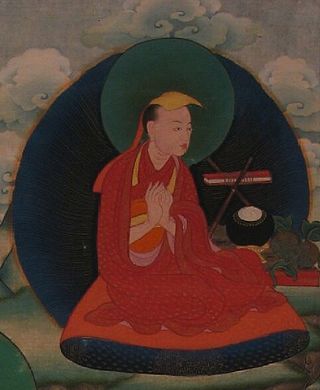
The Ganden Tripa, also spelled Gaden Tripa, is the title of the spiritual leader of the Gelug school of Tibetan Buddhism, the school that controlled central Tibet from the mid-17th century until the 1950s. The 103rd Ganden Tripa, Jetsun Lobsang Tenzin, died in office on 21 April 2017. Currently, Jangtse Choejey Kyabje Jetsun Lobsang Tenzin Palsangpo is the 104th Ganden Tripa.

Sera Monastery is one of the "great three" Gelug university monasteries of Tibet, located 1.25 miles (2.01 km) north of Lhasa and about 5 km (3.1 mi) north of the Jokhang.

Drepung Monastery, located at the foot of Mount Gephel, is one of the "great three" Gelug university gompas (monasteries) of Tibet. The other two are Ganden Monastery and Sera Monastery.
Ngawang Wangyal, aka Sogpo (Mongolian) Wangyal, popularly known as Geshe Wangyal and "America's first lama," was a Buddhist lama and scholar of Kalmyk origin. He was born in the Astrakhan province in southeast Russia sometime in 1901 and died in West Palm Beach, Florida in 1983. He came to the United States from Tibet in 1955 and was the spiritual leader of the Kalmuk Buddhist community in Freewood Acres, New Jersey at the Rashi Gempil-Ling Buddhist Temple. He is considered a "founding figure" of Buddhism in the West.

Geshe Ngawang Tashi Bapu a.k.a. Lama Tashi is former Principal Chant Master of Drepung Loseling Monastery, one of the largest monasteries of the Dalai Lama. In 2006, Lama Tashi was nominated for the Grammy Award for his album "Tibetan Master Chants" in the "Best Traditional World Music". Through this achievement, he has created the record of the first Buddhist Monk for Grammy Nomination in solo performance, and the first North-East Indian to be nominated for the prestigious Grammy Award the highest honour of Music in the world. Lama Tashi led Long Life Puja Chanting for the 14th Dalai Lama, the HE 99th and 100th Gaden Tripa Rinpoches and many more highly revered masters. The Long Life Puja is a very popular traditional healing ceremony that involves a multiphonic chant performance to heal the listeners and increase their life span. Lama Tashi also led the chanting performance of the Traditional Great Prayer Festival at Bodh Gaya presided over by the 14th Dalai Lama in 2002. Lama Tashi served as the Principal and the Director of the Central Institute of Himalayan Culture Studies, Dahung, India from 2003 to 2012 and 2012-2018 respectively. While at the institute, he taught Buddhist Philosophy at University level students.
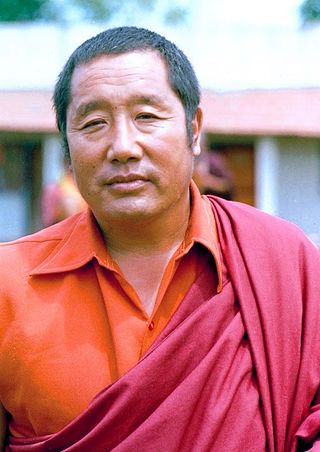
Kyabjé Drubwang Padma Norbu Rinpoche, 1932 – 27 March 2009, was the 11th throneholder of the Palyul Lineage of the Nyingma school of Tibetan Buddhism, and said to be an incarnation of Vimalamitra. He was widely renowned in the Tibetan Buddhist world as a master of Dzogchen. He was one of a very few teachers left from his generation who received all his training in Tibet under the guidance of what Tibetan Buddhists consider to be fully enlightened teachers.

Gaden Tharpa Choling Monastery is a Gelugpa monastery situated at the hilltop in Kalimpong, India. The monastery was founded by Domo Geshe Rinpoche Ngawang Kalsang in 1912. History says that Domo Geshe Rinpoche lived in Kalimpong in 1906 when he came to India for pilgrimage and to collect medicinal plants from India, Nepal and Bhutan. At the request of the Tibetan merchants and some Bhutanese leaders living in Kalimpong to establish a monastery there, Rinpoche instituted this monastery. Gaden Tharpa Choling monastery is a non-profitable development Association, registered under the West Bengal Societies Registration Act, 1961.

Kumbum Monastery, also called Ta'er Temple, is a Tibetan gompa in Lusar, Huangzhong County, Xining, Qinghai, China. It was founded in 1583 in a narrow valley close to the village of Lusar in the historical Tibetan region of Amdo. Its superior monastery is Drepung Monastery, immediately to the west of Lhasa. It is ranked in importance as second only to Lhasa.
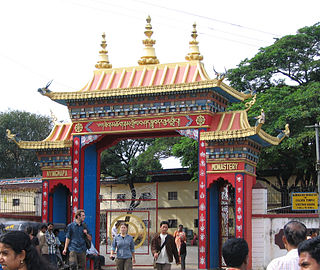
The Namdroling Nyingmapa Monastery or Thegchog Namdrol Shedrub Dargye Ling(བོད་ཡིག ཐེག་མཆོག་རྣམ་གྲོལ་བཤད་སྒྲུབ་དར་རྒྱས་གླིང་།), or ನಮ್ಡ್ರೋಲಿಂಗ್ ವಿಹಾರ is the largest teaching center of the Nyingma lineage of Tibetan Buddhism in the world. Located in Bylakuppe, part of the Mysuru district of the state of Karnataka, the monastery is home to a sangha community of over five thousand lamas, a junior high school named Yeshe Wodsal Sherab Raldri Ling, a religious college and hospital.

Jetsunma Ahkon Lhamo is a tulku within the Palyul lineage of the Nyingma tradition of Tibetan Buddhism. She gained international attention when she, a Western woman, was enthroned as a reincarnated lama. Since the mid-1980's she has served as spiritual director for Kunzang Odsal Palyul Changchub Choling, a Buddhist center in Poolesville, Maryland, which includes a large community of western monks and nuns. She also founded a center in Sedona, Arizona, U.S.A., and has small communities of students in California and Australia. Ahkon Lhamo has been described by her teachers, Tibetan lamas Penor Rinpoche, Gyatrul Rinpoche, as well as others such as Jigme Phuntsok, as a dakini or female wisdom being.

Zong Rinpoche was a Gelug Lama and disciple of the third Trijang Rinpoche, junior tutor of the 14th Dalai Lama. He was famous as a sharp analyst and master of philosophical debate, as well as a Tantric practitioner. He was the Abbot of Ganden Shartse monastery.
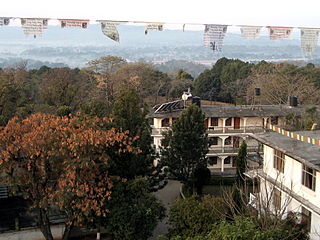
Lobsang Gyatso (1928–1997) was a Tibetan monk who founded the Institute of Buddhist Dialectics in Delhi, India.

Rato Dratsang, also known as Rato Monastery, Rato Dratsang is a Tibetan Buddhist monastery of the Gelug or "Yellow Hat" order. For many centuries, Rato Dratsang was an important monastic center of Buddhist studies in Central Tibet.

Kyabje Yongzin Ling Rinpoche is a Tibetan tulku. The best-known incarnation is the sixth incarnation, Thupten Lungtok Namgyal Thinley, a Tibetan buddhist scholar and teacher.
Tsenzhab Serkong Rinpoche was a master (tsenshab) of Tibetan Buddhism from the Gelug tradition. At the age of 34 in 1948 he was appointed from Ganden Jangtsey Monastery near Lhasa as one of seven teachers for the Dalai Lama.
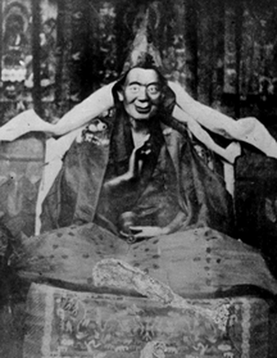
Domo Geshe Rinpoche is said to have been Shariputra, the Mahadsiddha Gayadhara, Dharmashri, Munijnana, Tönmi Sambhota, King Trisong Detsen, Dromtönpa, Milarepa, Khedrup Rinpoche, and Dragpa Gyaltsen in previous lives.

Although there were many householder-yogis in Tibet, monasticism was the foundation of Buddhism in Tibet. There were over 6,000 monasteries in Tibet. However, nearly all of these were ransacked and destroyed by Red Guards during the Cultural Revolution. Most of the major monasteries have been at least partially re-established, while many others remain in ruins.
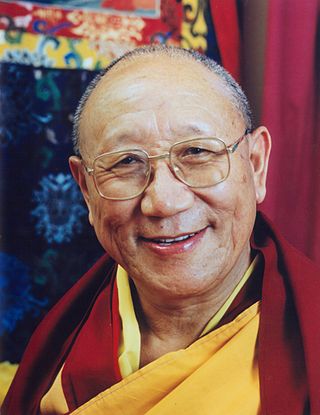
Kyabje Khensur Kangurwa Lobsang Thubten Rinpoche, was a Buddhist monk, Abbot of Sera Jey Monastery, and the founder of Tibetan Buddhist Institute (Adelaide). Khensur means "former abbot" and Rinpoche means "precious teacher."